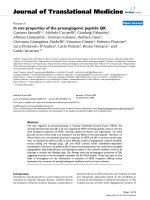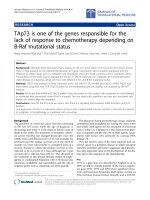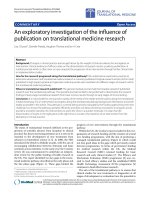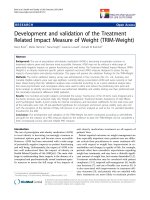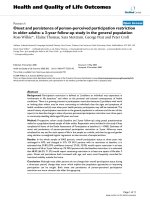báo cáo hóa học:" Undetected iatrogenic lesions of the anterior femoral shaft during intramedullary nailing: a cadaveric study" ppt
Bạn đang xem bản rút gọn của tài liệu. Xem và tải ngay bản đầy đủ của tài liệu tại đây (732.73 KB, 6 trang )
BioMed Central
Page 1 of 6
(page number not for citation purposes)
Journal of Orthopaedic Surgery and
Research
Open Access
Research article
Undetected iatrogenic lesions of the anterior femoral shaft during
intramedullary nailing: a cadaveric study
Stamatios A Papadakis*
†
, Charalampos Zalavras
†
, Raffy Mirzayan
†
and
Lane Shepherd
†
Address: Department of Orthopaedics, Keck School Of Medicine, LAC+USC Medical Center, University of Southern California, 1200 North State
Street, GNH 3900, 9312 Los Angeles, CA 90033, USA
Email: Stamatios A Papadakis* - ; Charalampos Zalavras - ; Raffy Mirzayan - ;
Lane Shepherd -
* Corresponding author †Equal contributors
Abstract
Background: The incidence of undetected radiographically iatrogenic longitudinal splitting in the
anterior cortex during intramedullary nailing of the femur has not been well documented.
Methods: Cadaveric study using nine pairs of fresh-frozen femora from adult cadavers. The nine
pairs of femora underwent a standardized antegrade intramedullary nailing and the detection of
iatrogenic lesions, if any, was performed macroscopically and by radiographic control.
Results: Longitudinal splitting in the anterior cortex was revealed in 5 of 18 cadaver femora
macroscopically. Anterior splitting was not detectable in radiographic control.
Conclusion: Longitudinal splitting in the anterior cortex during intramedullary nailing of the femur
cannot be detected radiographically.
Background
Currently the standard treatment for most femoral shaft
fractures in adults is intramedullary nailing (IMN) [1], as
it offers biomechanical and biologic advantages when
compared with other methods of fixation [2]. Although
femoral nailing is generally considered a technically
demanding procedure, the incidence of iatrogenic com-
plications associated with the technique has not been well
documented. Such complications include comminution
and, rarely, femoral neck fractures [3].
The purpose of this study is to report the observation of
undetected radiographically iatrogenic longitudinal split-
ting in the anterior cortex during intramedullary nailing
of the femur. A review of the English literature revealed no
similar reports.
Methods
As part of an ongoing study on the impact of the localiza-
tion of the entry point on mechanical complications dur-
ing nailing, 9 pairs of fresh-frozen intact femora from
adult cadavers, stripped of all soft tissues, were studied.
Standardized anteroposterior and lateral radiographs
were taken in all cadaveric femora, in order to exclude pre-
vious fractures or lesions, and to assess the medullary
canal diameter.
The nine pairs of femora were separated into 2 groups;
one group consisted of right femora and the other of left
Published: 17 July 2008
Journal of Orthopaedic Surgery and Research 2008, 3:30 doi:10.1186/1749-799X-3-30
Received: 12 September 2007
Accepted: 17 July 2008
This article is available from: />© 2008 Papadakis et al; licensee BioMed Central Ltd.
This is an Open Access article distributed under the terms of the Creative Commons Attribution License ( />),
which permits unrestricted use, distribution, and reproduction in any medium, provided the original work is properly cited.
Journal of Orthopaedic Surgery and Research 2008, 3:30 />Page 2 of 6
(page number not for citation purposes)
femora. The method of using pairs of femora from one
individual was chosen in order to minimize differences in
the anatomical shape and mechanical properties of the
two femurs. A standardized antegrade intramedullary
nailing technique was used in both groups. Specimens
were stored at -20°C. All specimens prior to testing were
thawed in a bath of normal saline at 30°C in order to be
appropriately hydrated. After they were thawed they were
mounted in a holding clamp. The starting point, directly
seen, was slightly anterior to the trochanteric fossa at
approximately the midline of the femoral neck in the first
group (right femora) and at the trochanteric fossa at
approximately the junction of the middle and posterior
third of the femoral neck in the second group (left fem-
ora). A guide wire was placed in the distinct starting point
of each group and the proximal femur was opened with a
cannulated drill. An end-cutting reamer was used to pen-
etrate the proximal metaphyseal bone. Reaming of 1.5
mm greater than the nail diameter was progressively per-
formed with care to avoid eccentric placement. Distal
medullary canal was reamed approximately 3 cm above
the intercondylar notch. When 10–13 mm in diameter
nails were used, the first 8 cm from the entry portal were
reamed to 14 mm in diameter in order to accept the larger
diameter proximal end of the nails, according to manufac-
turer's surgical technique. A fully slotted titanium
intramedullary nail with a 230 cm radius of curvature was
inserted (Uniflex, Biomet, Inc. Warsaw, IN). Table 1
shows the size of reamers and the diameter of the nails
used in the nine pairs of femora. The targeting device was
used for the insertion of the proximal locking screw,
whereas the distal one was inserted with a free-hand tech-
nique under image intensification.
After the procedure each femur was stored at -20°C to
allow an independent observer to perform a complete
inspection of every femur on a separate occasion, imme-
diately after they were thawed at room temperature. Every
iatrogenic lesion was recorded. Measurements on the fem-
ora were performed using a digital caliper (Digimatic,
Mitutoyo Corp., Japan, instrumental error ± 0.02 mm).
The measurements were performed in random order to
avoid bias and the left and right femora of the same pair
were never measured sequentially. Four measurements
were performed in every femur. These included: a) the dis-
tance between the most posterior and anterior margins of
the neck in the sagittal plane; b) the distance between the
posterior tip of the nail and the posterior margin of the
neck. Half of the diameter of the proximal part of the
inserted nail was added to this measurement to find the
distance of the exact entry point of the nail from the pos-
terior neck margin (absolute location); Subsequently, this
distance was divided by measurement (a) to calculate the
relative location of the entry point as a ratio of the anter-
oposterior neck diameter. This would take into account
potential differences in dimensions between the study
femora; c) the length of the fracture line, if any; d) the dis-
tance of the most proximal tip of the split from the neck
of the femur. All measurements were made in millimeters
(mm).
Standardized anteroposterior and lateral radiographs
were taken in all cadaver femora for identification of pos-
sible fractures, if any, after the procedures. Moreover, in
the presence of a fractured femur a fluoroscopic control
was undertaken for the possible detection of the fracture
line in different projections.
The absolute and relative location of the entry point in the
two groups was compared with the paired t-test. The prev-
alence of iatrogenic fractures in the two groups was com-
pared using the Fisher's exact test and the relative location
of the fractured and intact groups with the two-sample t-
test. All tests were two-tailed and p values less than 0.05
were considered significant.
Results
The average neck-shaft angle of the femora was 131.1
degrees (± 3.4° SD). Only one cadaver femur had an angle
of 140 degrees. The average neck-shaft angle for the first
group was 132.4 degrees (± 3.5° SD) whereas the average
neck-shaft angle for the second group was 130.5 degrees
(± 3.3° SD). This difference was not statistically signifi-
cant. The average distance between the most posterior and
anterior margins of the neck in the sagittal plane was 30.5
mm (Figure 1). In the first group the average distance was
31.5 mm and in the second group 29.5 mm. Also, this dif-
ference was not statistically significant. Therefore the anat-
omy of the studied femora did not differ between the two
groups.
The average distance of the entry point from the most pos-
terior margin of the femoral neck was 15.4 mm (± 2.3 SD)
for the first group and 9.1 mm (± 1.8 SD) for the second
group. This difference was statistically significant (p <
Table 1: Size of reamers and diameters of nails
Pairs Femora Reamer Size of nail
1 Right*/Left 13.5 12
2 Right/Left 14.5 13
3 Right/Left 14.5 13
4 Right/Left 15.5 14
5 Right*/Left 15.5 14
6 Right*/Left 16.5 15
7 Right/Left 11.5 10
8 Right*/Left 15.5 14
9 Right*/Left 13.5 12
The size of reamers and the diameter of the nails used in the nine
pairs of femora. Specimens in the first group (right femora) with
anterior femoral splitting are marked with an asterisk.
Journal of Orthopaedic Surgery and Research 2008, 3:30 />Page 3 of 6
(page number not for citation purposes)
0.001, paired t-test). The mean relative position of the
entry point expressed as a percentage of the anteroposte-
rior diameter of the superior surface of the femoral neck
was 49% (ranging from 41% to 57%) and 31% (ranging
from 26% to 36%) for the first and second group, respec-
tively. This difference was also statistically significant (p <
0.001, paired t-test) demonstrating that a distinct entry
point selection was achieved in each group (Figure 1).
Therefore, the two groups differed only with regards to the
exact location of the entry point.
Longitudinal splitting in the anterior cortex was revealed
in five of nine cadaver femora (56%) in the first group
(right femora) (Figures 2, 3), whereas in the second group
(left femora) no splitting was detected. All cases of longi-
tudinal splitting were nondisplaced cracks and there were
no cases of bursting of the femur. The increased preva-
lence of splitting in the first group was statistically signifi-
cant (p = 0.029, Fisher's exact test). The average length of
the longitudinal split was 30.7 mm (± 19.9 SD) and the
average width of the split was 2.5 mm (± 1.5 SD). The
average distance of the most proximal tip of the split from
the neck of the femur was 59.7 mm (± 8.7 SD) and it was
at the level of the lesser trochanter in all five fractured
specimens. Comparison of the fractured versus the intact
specimens showed a significantly more anteriorly placed
entry point in the first group; the mean relative position
of the entry point was 48% (± 6% SD) in the fractured
group versus 37% (± 10% SD) in the intact group (p =
0.04, two-sample t-test).
No other fractures were found during inspection or radio-
graphic control either in the first or in the second group.
The radiographic and fluoroscopic control in the five frac-
tured femora revealed no sign of the longitudinal split in
anteroposterior and lateral projections (Figures 4, 5).
Discussion
Treatment of fractures of the femoral shaft can be associ-
ated with technical errors leading to numerous iatrogenic
complications during closed intramedullary nailing of the
femoral shaft [4,5]. An inappropriate entry point for nail
insertion into the proximal femur could result in fracture
site comminution, proximal femur and even femoral neck
fracture [4,6].
Johnson et al [5] found that an entry point too anteriorly
to the midline of the femur results in greater hoop stresses
in the femoral cortex, and probably in femoral bursting. A
biomechanical study carried out by Tencer et al [7] has
shown that placement of the starting hole 6 mm or more
anterior to the neutral axis of the femur is likely to result
It is evident the longitudinal splitting in the anterior cortex of a femurFigure 2
It is evident the longitudinal splitting in the anterior
cortex of a femur.
Point (A) demonstrates the distinct entry point for the first group (right femora), whereas point (B), demonstrates the distinct entry point for the second group (left femora)Figure 1
Point (A) demonstrates the distinct entry point for
the first group (right femora), whereas point (B),
demonstrates the distinct entry point for the second
group (left femora). (AT), indicates the anterior third of
the femoral neck in the sagittal plane; (MT), the medial third;
and (PT), the posterior third.
Journal of Orthopaedic Surgery and Research 2008, 3:30 />Page 4 of 6
(page number not for citation purposes)
in consistent cracking of the proximal femur. Alho et al [8]
also reported a 26% prevalence of proximal fragment
comminution with an anterior insertion of the intramed-
ullary nail. However, none of these studies used radio-
graphic control to investigate the diagnosis of such
lesions.
The placement of the nail more anteriorly to the posterior
third of the neck in this study was complicated with a
prevalence of 56% of anterior femoral splitting. All of
these lesions were seen during nail insertion, at its final
phase. A possible explanation could be that during ream-
ing the flexible shaft of the reamers could easily follow the
curved path of the medullary canal, as the femur is convex
anteriorly. On the other hand, during nail insertion the
relevant stiffness of the nail, the mismatch in curvature
between the inserted nail and the medullary canal, in
combination with an entry point anterior to the tro-
chanteric fossa has possibly led to the femoral splitting. As
described in an article by Egol et al [9], the average femo-
ral anterior radius of curvature is 120 cm (SD ± 36) and
there is a significant mismatch between the anatomical
radius of curvature of the femur and most intramedullary
nails, including the one used in this study. In the same
study, the analysis of the radii of curvature of 8 current
antegrade intramedullary nails demonstrated that they all
have a greater radius of curvature ranging from 186 to 300
cm (straighter) than that of the average femur. However,
this is only one factor affecting nail insertion. As previ-
ously stated the placement of the starting point slightly
anteriorly to the neutral axis of the medullary canal forces
the nail to travel anteriorly and thus, increased hoop-
stresses cause splitting of the anterior femoral cortex [5,7].
C-arm images or plain films were used to evaluate the
specimens after fixation, as this type of radiographic anal-
ysis is commonly used in clinical practice. C-arm fluoros-
Anteroposterior radiograph of the same femurFigure 4
Anteroposterior radiograph of the same femur. No
evidence of fracture line can be documented.
Close-up photo of the splitting in the same femurFigure 3
Close-up photo of the splitting in the same femur.
Journal of Orthopaedic Surgery and Research 2008, 3:30 />Page 5 of 6
(page number not for citation purposes)
copy is the preferable means of monitoring IMN
intraoperatively. However, C-arm images often do not
reveal subtle fractures that plain radiographs might, as the
quality of the images using C-arm fluoroscopy is usually
worse than that of plain radiographs [10].
In this study, the anterior splitting was not detectable
either in radiographic or fluoroscopic examination appar-
ently because of the vertical orientation of the fractures
and the overlapping density of the bone cortex and the
intramedullary nail. Imaging confirmation of the splitting
by using either radiographs obtained in multiple different
projections other than the anteroposterior and lateral
ones, or a CT-scan study, was not performed as these
means are not used intraoperatively.
The bone density of the cadaveric femora was not tested.
By using pairs of intact femurs from one individual donor,
any variability in the mechanical properties of the paired
specimens is minimized and differences in the bone
strength are not expected. Moreover, there were no simu-
lated diaphyseal fractures, as it is generally difficult to sim-
ulate identical patterns of fractures (i.e., single,
comminuted, etc.).
It should be noted that this study has several limitations.
The main weakness is that this study involved intramedul-
lary nailing of intact cadaveric femora; therefore our find-
ings may not be replicated in the surgical practice of
intramedullary nailing of femur fractures for two reasons.
First, cadaveric bone stripped of soft tissue, frozen, and
thawed is hard and has very limited ability of compliance
compared to live bone; therefore the effects of the location
of the entry point and of the curvature mismatch between
the nail and the medullary canal were magnified. Second,
intact femora were nailed, which again augmented
stresses on the femur; in the presence of a fracture, entry
point variations and curvature mismatch may be accom-
modated to a degree by displacement at the fracture site.
However, this study used matched pairs of femurs, the
identical implant by a single manufacturer, and a stand-
ardized antegrade nailing technique with the exception of
the entry point; all cases of anterior splitting occurred in
femora with more anteriorly located entry points, which
emphasizes the importance of the location of the entry
point in the worst case scenario of a hard and incompliant
intact femur.
Finally it should be noted that all cases of longitudinal
splitting were nondisplaced cracks undetectable fluoro-
scopically or radiographically. Hence, it could be argued
that such a nondisplaced crack may have minimal effect
on the stability of fixation and, consequently, minimal
clinical relevance. However, this necessitates static locking
of the nail to impart rotational and longitudinal stability
to the construct [2]. Although anterior femoral splitting
has never been described, detected or led to clinical rele-
vant complications as seen by non-existing literature, we
feel that surgeons should be aware of this potential com-
plication, especially if the entry point used is too anterior.
Our findings add support to the current recommendation
of static IMN for all types of femur fractures [11].
In conclusion, this study has drawn attention to the risk of
undetectable iatrogenic splitting in the anterior cortex
Lateral radiograph of the same femurFigure 5
Lateral radiograph of the same femur. No evidence of
fracture line can be documented.
Publish with BioMed Central and every
scientist can read your work free of charge
"BioMed Central will be the most significant development for
disseminating the results of biomedical research in our lifetime."
Sir Paul Nurse, Cancer Research UK
Your research papers will be:
available free of charge to the entire biomedical community
peer reviewed and published immediately upon acceptance
cited in PubMed and archived on PubMed Central
yours — you keep the copyright
Submit your manuscript here:
/>BioMedcentral
Journal of Orthopaedic Surgery and Research 2008, 3:30 />Page 6 of 6
(page number not for citation purposes)
during antegrade intramedullary nailing of intact cadav-
eric femora. The clinical significance, if any, of this lesion
is unknown.
Competing interests
The authors declare that they have no competing interests.
Authors' contributions
SAP, CZ, RM, and LS participated in the design of the
study, analysis and writing of this manuscript. SAP and CZ
participated also in revising critically the manuscript. All
authors read and approved the final manuscript.
References
1. Krettek C: Intramedullary nailing. In AO Principles of Fracture Man-
agement CD-Rom edition. Edited by: Ruedi TP, Murphy WM. Stutt-
gart-New York: AO Publications, Thieme; 2000.
2. Kottmeier SA: Femoral shaft fractures. In Principles of Orthopaedic
Practice 2nd edition. Edited by: Dee R. USA: McGraw-Hill Inc;
1997:483-494.
3. Christie J, Court-Brown C: Femoral neck fracture during closed
medullary nailing. Brief report. J Bone Joint Surg Br 1988, 70:670.
4. Christie J, Court-Brown C, Kinninmonth AW, Howie CR:
Intramedullary locking nails in the management of femoral
shaft fractures. J Bone Joint Surg Br 1988, 70:206-210.
5. Johnson KD, Tencer AF, Sherman MC: Biomechanical factors
affecting fracture stability and femoral bursting in closed
intramedullary nailing of femoral shaft fractures, with illus-
trative case presentations. J Orthop Trauma 1987, 1:1-11.
6. Winquist RA, Hansen ST Jr, Clawson DK: Closed intramedullary
nailing of femoral fractures. A report of five hundred and
twenty cases. J Bone Joint Surg Am 1984, 66:529-539.
7. Tencer AF, Sherman MC, Johnson KD: Biomechanical factors
affecting fracture stability and femoral bursting in closed
intramedullary rod fixation of femoral fractures. J Biomech Eng
1985, 107:104-111.
8. Alho A, Stromsoe K, Ekeland A: Locked intramedullary nailing of
femoral shaft fractures. J Trauma 1991, 31:49-59.
9. Egol KA, Chang EY, Cvitkovic J, Kummer FJ, Koval KJ: Mismatch of
current intramedullary nails with the anterior bow of the
femur. J Orthop Trauma 2004, 18:410-415.
10. Yeom JS, Kim WJ, Choy WS, Lee CK, Chang BS, Kang JW: Leakage
of cement in percutaneous transpendicular vertebroplasty
for painful osteoporotic compression fractures. J Bone Joint
Surg Br 2003, 85:83-89.
11. Browner BD, Caputo AE, Mazzocca AD: Femur fractures:
Intramedullary nailing. Master Techniques in Orthopaedic Surgery:
Fractures. CD-Rom .
